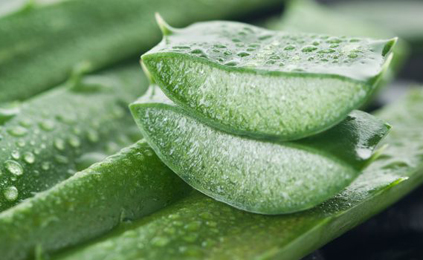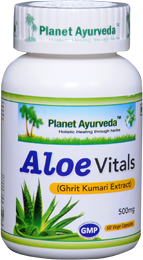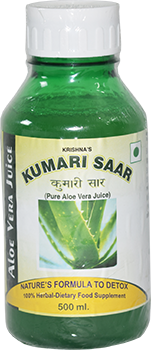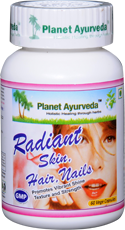Ghritkumari - Aloe Vera (Aloe Barbadensis) - Medicinal Properties, Benefits, Dosage

Description of the Ghritkumari
Ghritkumari is a famous herb used in Ayurveda since long time ago. It is known with the scientific name, Aloe barbadensis. It belongs to the family liliaceae. It is perennial, xerophytic, shrubby and pea green colour plant. These stems are stout and thick. It grows up to 80 to 100 cm in length. The root system is of fibrous type. The plant has thick, lanceolate, fleshy leaves having sharp points. These leaves can grow up to 18 inches long and 2 inches wide. These are of green to grey green colour. The leaves are evenly long and of triangular shape. The leaves of the plant consists of three layers, inner layer has 99% water and other 1% is filled with biochemical. Middle layer is formed of latex, have yellow colour sap in it. Last is the outer layer, a thick layer made of 15 to 20 cells, protects the whole plant. The leaves of the plants are rich in water so it can survive for years and years. The leaves has spiky type margins. Flowers of the kumari is cylindrical, pendulous and of dense racemes. These are of yellow colour and long up to 2 to 3 cm. the roots of the plants are thick and fibrous. The plant fruits are of triangular shape and containing plenty of seeds in it.
General Description
Ghritkumari or Aloe barbadensis is famous with a name, Aloe vera. The word aloe vera derived from a word, known as Alloeh. Alloeh is an Arabic word which defines itself as a substance with shining bitter character. Vera is a Latin word which means true.
There are evidences that Ghritkumari is widely used since ancient times. Alexander and Christopher Columbus used aloe vera to treat wounds of the soldiers. Kumari is mentioned in ancient texts also such as in Vedas (600 BC), Samhitas (1500-600 AD), Nighantus and more.
The Ghritkumari plants consists of various active phytochemicals which shows great importance in providing relief from ailments.
Various Active Phytochemicals are as following:
Anthraquinone
There are about 12 anthraquinones. Aloin and emodine are from those 12 anthraquinones. These compounds enriched with anti-bacterial, anti-viral and analgesic properties.
Amino acids
It contains 20 amino acids which are required by humans and 7 to 8 essential amino acids. These amino acids known to provide anti-bacterial and anti-inflammatory effects.
Carbohydrates
Ghritkumari consists of monosacchrides and polysaccharides.
Hormones
Hormones of Ghritkumari play vital role to treat various diseases. Some of the hormones are gibberellins and auxins. These have healing and anti-inflammatory properties.
Vitamins
Ghritkumari contains vitamins like A, C and E, folic acid, choline and B12. These nourish blood, body cells and to neutralize free radicals.
Fatty acids
Kumari provides four kinds of steroids. These are campesterol, lupeol, cholesterol and B sisosterol. These steroids have properties like analgesic, anti-inflammatory and antiseptic.
Inorganic components
These consists various minerals such as copper, selenium, magnesium, sodium and more. These are important in the various enzyme systems. These systems perform various metabolic functions and some of these act as antioxidants.
Enzymes
It consists of various enzymes like catalase, alkaline phosphatase, amylase, bradykinase cyclooxidase, cylooxygenase, lipase, oxidase, carboxypeptidase, carboxylase and superoxidase dismutase. These are essential in catabolism of fats and carbohydrates. One of the enzyme bradykinase helps to reduce severe inflammation when applied on the skin.
Classification
- Kingdom - Plantae
- Subkingdom – Tracheobionta
- Superdivision - Spermatophyta
- Division - Magnoliophyta
- Class - Liliopsida
- Subclass - Liliidae
- Order - Liliales
- Family - Aloeaceae
- Genus - Aloe
- Species - Barbadensis
Habitat
Ghritkumari is native to the Mediterranean region of North Africa, Canary Islands and Southern Europe. It is cultivated in USA, Mexico, Asia, southern Europe, Aruba, Bonaire, Bermuda, West Indies, the Bahamas, Central and South America. It spreads as wild in the coasts and coastal regions of south India. It also grows in parts of these cities, Maharashtra, Madhya Pradesh, Chhattisgarh and Gujarat.
Ghritkumari Alternative Names
- Sanskrit Name - Ghritkumari, Kumari, Gruha Kanya, Vipulasrava
- English Name – Indian Aloe, Aloe Vera
- Hindi Name - Guarpatha, Ghikanvar, Rambans
- Malyalam Name - Kumara, Kattar Vazha
- Marathi Name - Korphad, Kunvarpata
- Bangali Name – Ghritkumari
- Tamil Name – Chirukuttali
- Gujrathi Name - Kunwar Path
- Telugu Name - Chinna Kalabanda
- Oriya Name - Kumara
- Kannada Name - Lolisara
Ayurvedic Properties of Ghritkumari
| Hindi / Sanskrit | English | ||
| Rasa | Tikta | Taste | Bitter |
| Guna | Guru, Snigdha, Pichhila | Physical Property | Heavy, Unctuous, Sticky |
| Virya | Sheeta | Potency | Cold |
| Vipaka | Katu | Metabolic Property (After Digestion) | Pungent |
Ghritkumari Effects on Doshas
It helps to balances all three doshas.
Classical Categorization
There is no independent information regarding Ghritkumari observed in classical texts of Ayurveda.
In Samhitas – it is mentioned as a single drug and as one of the herbs used for making herbal formulations.
Acharya Sharangdhara explained one of the famous formulation of Ghritkumari in 13th century. It is known as Kumariasava.
Acharya Shodal introduced Ghritkumari in Nighantus in 14TH century.
Acharya Shodal described it as Kushthavinashini (drug destroy all kinds of skin diseases).
Acharya kaiyadeva mentioned kumari as rasayana means rejuvenator and vrasya means aphrodisiac.
Kaiyadeva nighantu encloses the benefits of Ghritkumari flowers. They specified the flowers as a vermicidal.
Ancient Verse of Ghritkumari

Bhavprakash nighantu edition of 1998: verse 230, page no-419-421.
It states the names and the properties of Ghritkumari. It is known as kumari, Gruha Kanya, kanya and Ghritkumarika.
It is purgative in nature with cold potency, bitter and sweet in taste, good for eyes, rejuvenating, provides strength to the body, aphrodisiac and balances vata.
It manages spleen and liver disorders, kapha fever, skin burns, skin diseases and blood impurities.
References
The Bhavprakash nighantu with elaborated Hindi commentary by Padmashri prof. K.C. Chunekar, edited by Dr. G.S. Pandey: Edition of 1998, verse 230, page no. 419-421.
Practical Uses of Ghritkumari
- It helps to stabilize blood sugar level, hence is good for diabetes.
- It is helpful to cure burns and other skin disorders.
- It give relief from wounds and ulcers.
- It prevents growth of acne and moisturizes the skin.
- It helps to treat fungus, insect bites, herpes, vaginal infections and allergic reactions.
- Its juice is a tonic in conditions like jaundice, amenorrhea and piles.
- It is antiseptic, helps to kill many of viruses and bacteria.
- It helps to alkalize the body, balances acid production and treats constipation.
- It prevents kidney stones, crohn's disease and IBS.
- It also controls the levels of cholesterol and oxidative stress.
Parts Used
Leaves
Dosage
- Leaf pulp – 1-3 grams
- Fresh juice – 10-20 ml
- Aqueous extract – 100-300 mg
Precautions
Avoid use in pregnancy and breast feeding.
Oral intake of aloe can cause abdominal cramps and diarrhea sometimes.
Ayurvedic Products from Ghritkumari by Planet Ayurveda
1. ALOE VITALS
Aloe Vitals can treat various health disorders and eczema because it counteracts inflammation naturally. The vitamins C and E in Aloe helps the skin to recover from the skin inflammation associated with various ailments. Aloe contains important constituents such as isobarbalin, aloe-emodin, aloetic acid, homonataloin, chrysamminic acid and galactouronic acid.
2. KUMARI SAAR
Kumari Saar is the aloe vera juice extract which is used for the purpose of relieving various ailments. Aloe extract is enriched with various medicinal properties. It can be used to relieve skin conditions like eczema, ulcers, psoriasis, acne, bites and stings. Other ailments like arthritis, asthma, colitis and diverticulitis also can be relieved with Aloe vera juice.
3. ALOEVERA SCRUB OIL CONTROL FACE WASH
This is wonderful product of Planet Ayurveda which is useful for all kinds of skin. It is also beneficial for oily skin. The ingredients used in this face wash are purely natural and herbal which are suitable for all kinds of skin. It is 100 % natural product which helps to rejuvenate the skin and helps to remove dead cells from skin surface. It helps to remove acne, scars, burns, blemishes and sun burns.
4. RADIANT SKIN HAIR NAIL FORMULA
This special capsule contains natural ingredients that aid in the skin cell repair and growth. It helps to provide firmness, smoothness and elasticity to skin. This formula can help to relieve ringworm, psoriasis as well as acne and stubborn pimples. Radiant skin, hair and nail formula helps to relieve skin problems such as eczema naturally. It helps to grow stronger and longer nails. This product gives brittle and dry nails all the moisture and care they need in order to stay healthy. This herbal formula helps to keep skin glowing and moist. It is also known to make the hair strong and lustrous.







